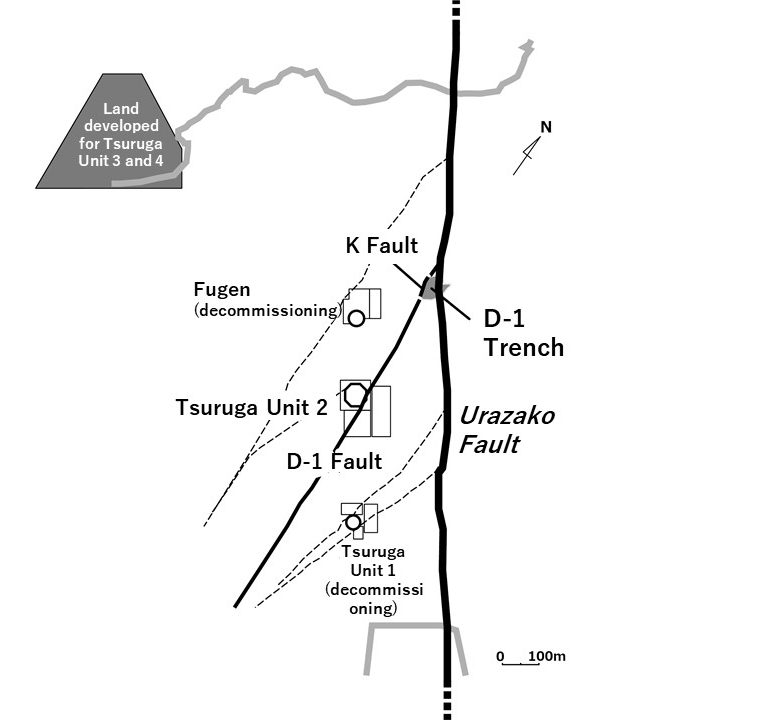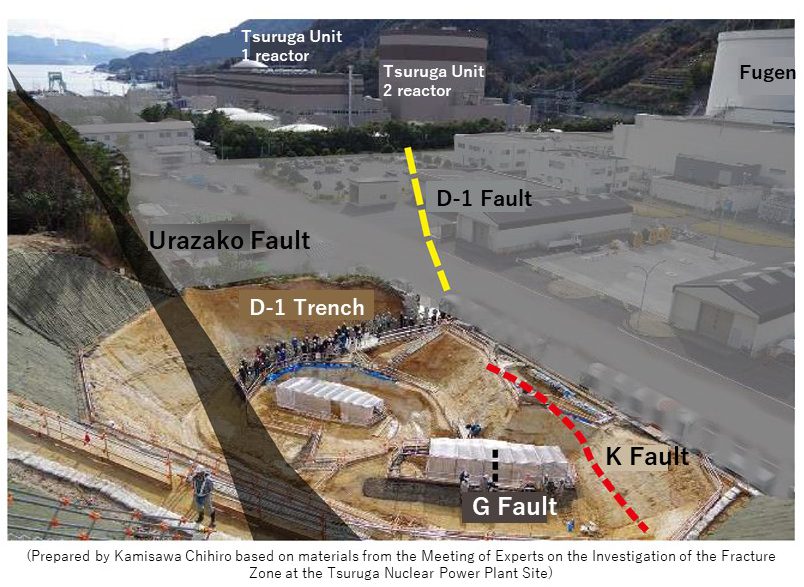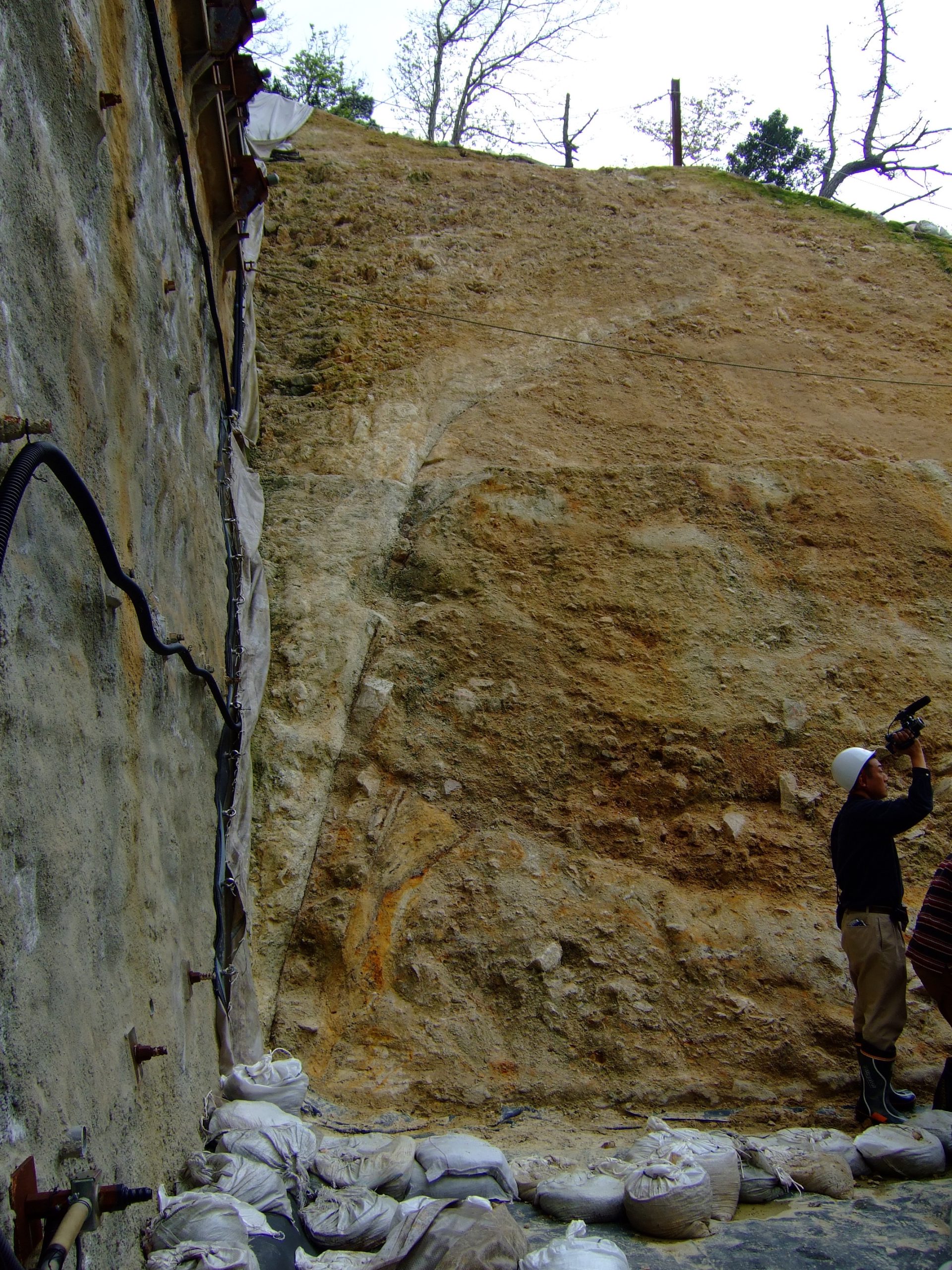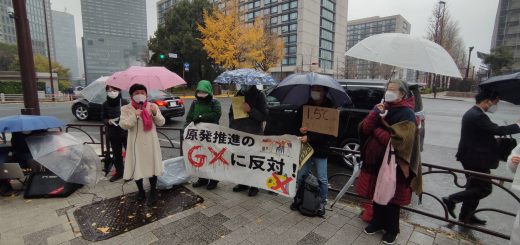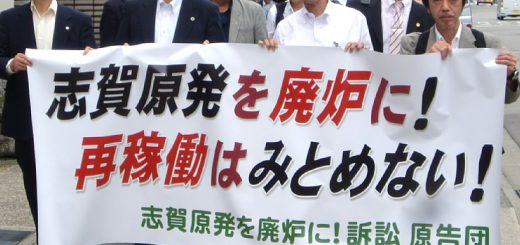Denial of Approval to Restart due to Active Fault Under Tsuruga Unit 2 Reactor
By Kamisawa Chihiro
Official decision to deny approval
At the review meeting for compliance with the new regulatory standards 1) on July 26, the Nuclear Regulation Authority (NRA) review team concluded that it cannot be denied that the fault directly below the Tsuruga Unit 2 reactor was an active fault. A draft of the review document stating the denial of approval for the Tsuruga Unit 2 reactor application for permission to change the reactor installation was prepared and submitted for public comment.
Based on the results of the public comments, the NRA officially issued the final review document on November 13, thereby declining to approve the application for permission to change the reactor installation of the Tsuruga Unit 2 reactor. 2) The Japan Atomic Power Company (JAPC) now has a reactor with no outlook for operation.
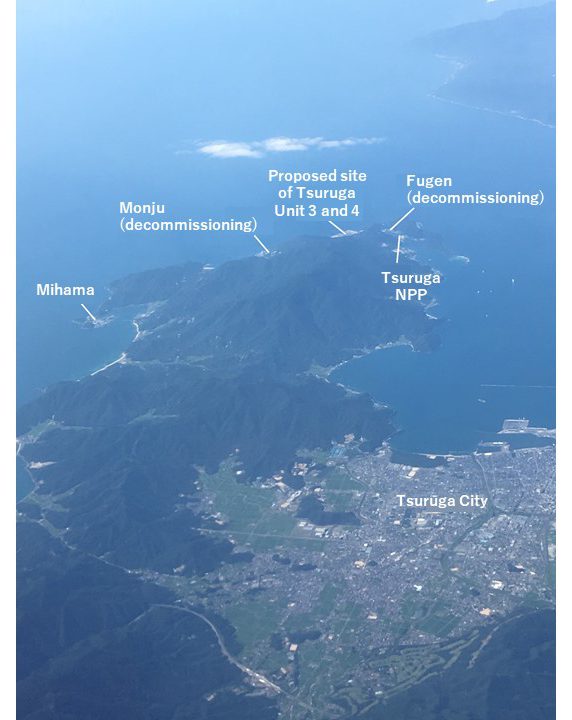
Figure 1: The Tsuruga Peninsula and the Nuclear Power Plant (Photo taken by Kamisawa Chihiro on July 21, 2017)
It can be said that in applying the new regulatory standards scientifically for the first time in the review of a nuclear facility site the NRA made a sound judgment. However, the NRA could have terminated the review at an earlier stage. In addition, if the former regulatory and review bodies (the Nuclear and Industrial Safety Agency, the Nuclear Safety Commission, the Agency for Natural Resources and Energy, and the Science and Technology Agency) had not overlooked the large fault (the Urazoko Fault) on the Tsuruga Peninsula and had made an appropriate judgment, the construction and operation of the Tsuruga Nuclear Power Plant could have been stopped at that stage.
Ground displacement caused by the K Fault
The judgment of this review was made with regard for the “shear” of the ground on which the Tsuruga Unit 2 reactor is built.
There are numerous small faults on the site of the Tsuruga NPP (more than 100 of them are listed in JAPC materials), many of which branch off from the Urazoko Fault. The K Fault, at the center of the discussion at the review meeting of the Tsuruga Unit 2 reactor, is derived from the Urazoko Fault and heads directly under the reactor. Rather than causing earthquakes by its own movement, the characteristic of K Fault is that it moves when the Urazoko Fault moves and would destroy the ground directly under the reactor.
Concerning K Fault, the Tsuruga Unit 2 reactor review team within the NRA says:
- Based on clear evidence, we cannot deny that K Fault has been active since the Late Pleistocene (about 120 to 130 thousand years ago or later).
- In consideration of the accuracy and reliability of the survey results of geological observation, it cannot be said that judgments on the side of safety have been made, and it cannot be denied that K Fault does not continue southward from the D-1 trench.
It has therefore been concluded that the fault does not conform to Article 3, Paragraph 3 of the Standard Regulations on Permissions for Installations (“Interpretation of Regulations Concerning Standards for the Location, Construction and Equipment of Commercial Power Reactors and their Accompanying Facilities”3), which stipulates that “Seismically important facilities and associated casks shall be installed on ground where displacement is unlikely to occur.”
The fault running directly under the reactor building of the Tsuruga Unit 2 reactor may possibly move in the future, and it has been judged that in that case the reactor building and important equipment inside it may be destroyed.
Existence of the Urazoko Fault
The Urazoko Fault is located 250 meters east of the Tsuruga Unit 2 reactor. The fault is listed as having a degree of certainty I (first-class) in the “New Edition of Active Faults of Japan” (1991) published by the Japanese Society for Active Fault Studies. Takagi Jinzaburo introduced this fact in his contribution to the Journal of the Physical Society of Japan immediately after the Great Hanshin-Awaji Earthquake disaster, and its existence was well known to those interested in nuclear safety.
The Urazoko Fault is located at the northwest end of the 35-km long Urazoko-Yanagaseyama Fault Zone. If this active fault moves, the ground surface on the far side of the fault would shift to the left, destroying the bedrock and setting off a magnitude 7.4 earthquake. The amount of displacement in a single earthquake would be two meters, and it is a very active fault that has been found to have moved as recently as about 4,500 years ago. Some studies consider the fault to be part of the Yanagase-Sekigahara Fault Zone, which includes active faults to the southeast part of the fault zone. In this case, the fault zone is 65 km long and the resulting earthquake would reach magnitude 7.8.
Current science does not provide a reliable way to estimate to what degree the Tsuruga Unit 2 reactor will shake in the event of a magnitude 7.4 earthquake. This is because the shortest distance from the fault is very close, and it is also necessary to estimate the amplification effect of the shaking depending on the fault’s rupture initiation point (epicenter) and the direction of rupture.
JAPC assumed only a maximum horizontal acceleration of 800 gal as the basic ground motion for the Tsuruga Unit 2 reactor. However, assuming a maximum horizontal acceleration of 1,000 gal or 2,000 gal does not mean that seismic evaluation or seismic reinforcement can be performed based on that assumption. The truth is that we cannot even discuss how great the assumed maximum acceleration should be before we can say that it is sufficient.
It has been shown that when a large earthquake occurs, in association with the tremors, large ground destruction will occur over a wide area around the site of the Tsuruga NPP.
Is the spent fuel OK?
The Tsuruga NPP still has about 630 tons of spent fuel in the spent fuel pool of Unit 1 and the spent fuel storage pit of Unit 2. To the immediate north of the reactor is the decommissioned advanced thermal reactor Fugen, which also has about 70 tons of spent fuel.
On August 28, before the public comments began, the NRA wrote the following in its Summary of the Draft Outcome of the Review. “Regarding the spent fuel storage facility of Unit 2, a report was requested and received immediately after the first decision of the Meeting of Experts on the Investigation of the Fracture Zone at the Tsuruga Nuclear Power Plant Site (May 29, 2013). A report on the soundness of the fuel assemblies in the event of a loss of cooling water was received from JAPC. As a result, it was concluded that the assessment results were appropriate and that there was no need to request additional measures (October 9, 2013), and therefore additional measures will not be requested.”
The contents of the assessment presented by JNR described what would happen to the spent fuel and what would happen to the dose rate at the site boundary in the case of a cooling water leak and in the case of a total loss of cooling water from the spent fuel pit of Unit 2.
The assessment states that in the case that for some reason the cooling water leaks from the spent fuel pit, it would take 76 hours for the water level to fall to 2 meters above the spent fuel. During this time, it would be possible to recover the water level by replenishing cooling water.
In the case of a total loss of cooling water, even if water could not be injected into the pit, the spent fuel stored in the rack would be cooled by circulation in the gaseous phase from the natural environment, the temperature of the cladding surface rising to a maximum of 420 degrees centigrade, at which no damage would occur. If water was injected, cooling of the gaseous phase would be hindered, and the temperature of the cladding surface would rise to a maximum of 503 degrees centigrade, but even then the spent fuel would not be damaged. The radiation dose rate at the site boundary could rise by a maximum of 3 microsieverts per hour.
In neither case is it assumed that an earthquake with the Urazoko Fault as the epicenter would cause major destruction of the nuclear facilities, and thus it is very easy to come up with such an assessment. In the first case, it is strange to think that it would be easy to bring up a supply of water on the NPP site immediately after an earthquake. Further, in the case of total loss of cooling water, if the racks are sound and the gas flow path is in an ideal condition, the expected cooling in the gaseous phase may occur, but it is inappropriate to incorporate this expectation into the assumptions for an assessment of a possible event after a major earthquake. The racks will be destroyed and the spent fuel will be damaged. Many objects will also fall from the ceiling and surroundings. Since the approval of the restart of the reactor was denied on the basis that ground destruction could occur, it is necessary to request appropriate measures for any future situation.
In his book, Professor Watanabe Mitsuhisa of Toyo University says of the Tsuruga NPP and the Urazoko Fault that he is indeed thankful for the “good fortune that the reactor has been operated without an accident for 40 years at a distance of 250 m from a first-class active fault,” but we cannot bank on our luck in the future.
Footnotes (Japanese)
1) www.da.nra.go.jp/detail/NRA100003866
2) www.da.nra.go.jp/detail/NRA100006517
3) www.nra.go.jp/data/000382455.pdf
■ References
Kamisawa Chihiro, Has the Nuclear Regulation Authority implemented regulations properly over the past ten years? CNIC Tsushin No. 583 (January 1, 2023), cnic.jp/46137 (Japanese)
Kamisawa Chihiro: Deny Tsuruga Nuclear Power Plant Approval! Hangenpatsu Shimbun No. 556 (July 2024)
Takagi Jinzaburo, Nuclear Facilities and Emergencies: Focusing on an Examination of Earthquake Countermeasures, Journal of the Physical Society of Japan, Vol. 50, No. 10, 1995, p. 818-821, www.jstage.jst.go.jp/article/butsuri1946/50/10/50_10_818/_pdf/-char/ja (Japanese)
Nuclear Regulation Authority, Assessment of the Report on the Spent Fuel Storage Facility of Tsuruga Nuclear Power Plant Unit 2 from the Japan Atomic Power Co., Ltd. (Draft), October 9, 2013 (Included in the Summary of the Draft Results of the Examination on the Application for Permission to Change the Installation of a Nuclear Reactor for Power Generation (Change in Unit 2 Power Reactor Facility) of Tsuruga Nuclear Power Plant, Japan Atomic Power Co., Ltd.) (Japanese)
www.da.nra.go.jp/view/NRA100004525?contents=NRA100004525-004-003#pdf=NRA100004525-004-002
Watanabe Mitsuhisa: The Future of the Land Can Be Understood from Landforms, Nikkei BP (December 2014) (Japanese)
